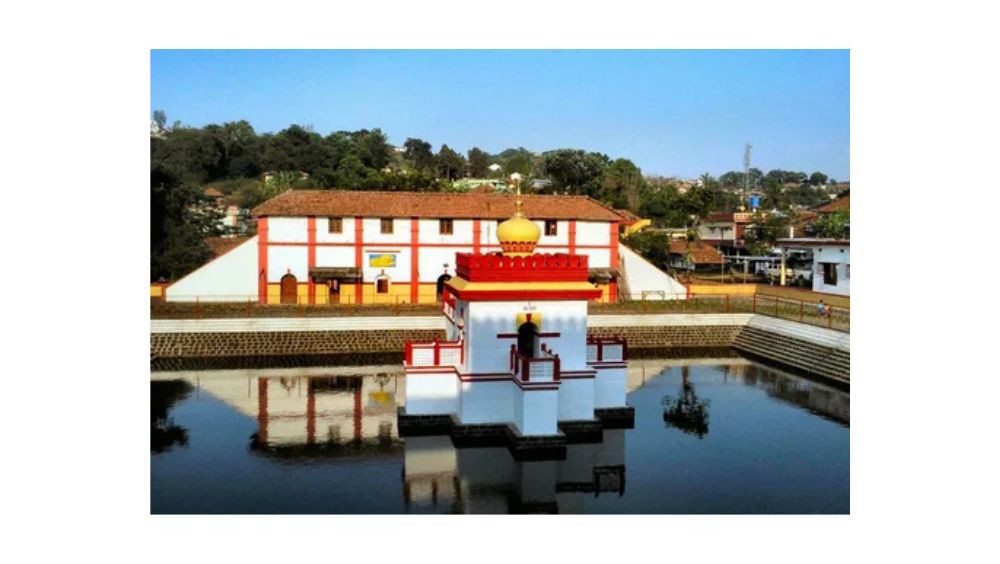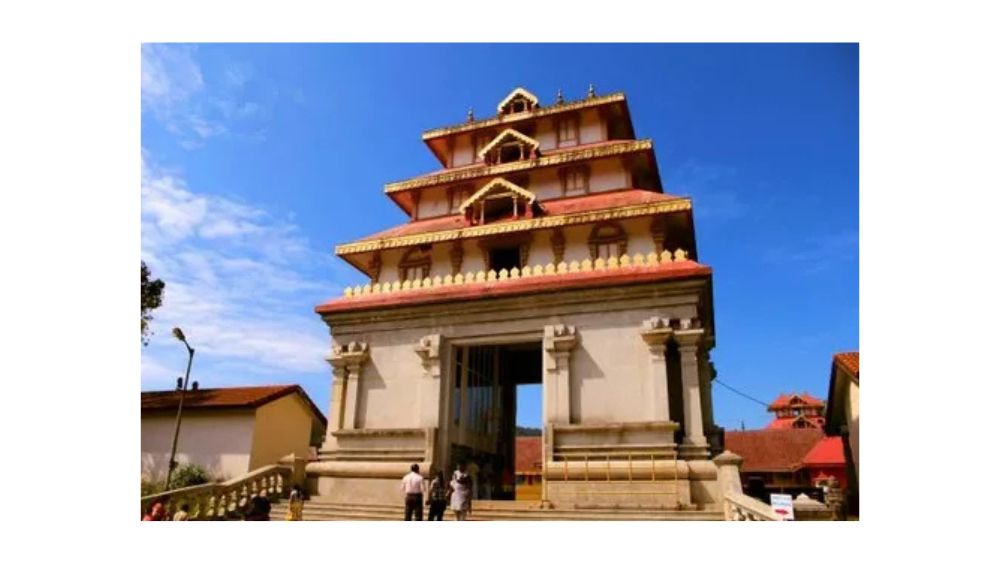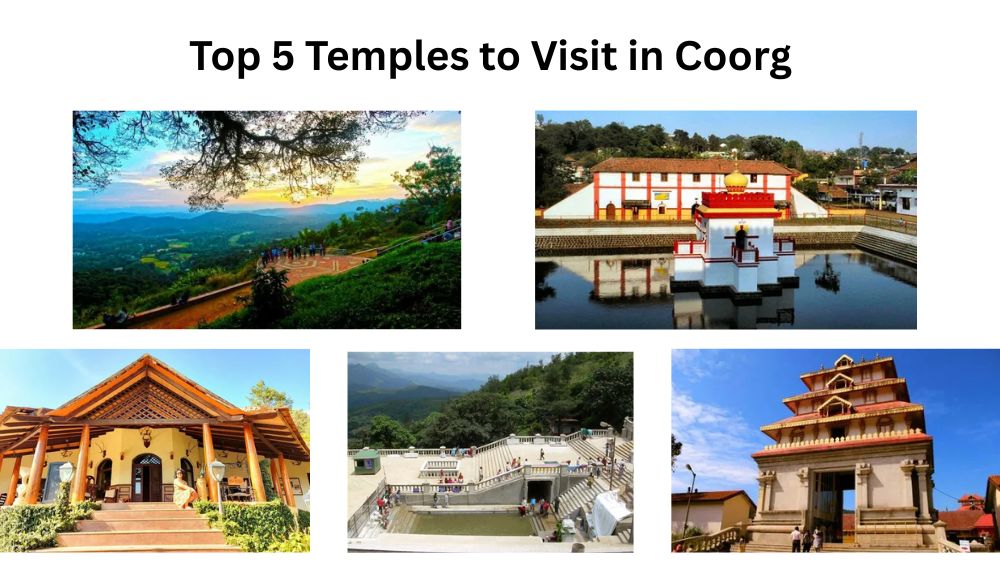Best Must-Visit Temples in Coorg For Unique Experience
Table of Contents
Introduction
Top 5 Temples to Visit in Coorg, Coorg, also known as Kodagu, is a land known for its breathtaking natural beauty, lush coffee plantations, misty hills, and serene atmosphere. But beyond its scenic landscapes, Coorg is also home to a number of beautiful temples that are steeped in history, culture, and spirituality. Whether you are a devout traveler or simply a lover of history and architecture, these temples offer an enriching experience.
1. Omkareshwara Temple: The Fusion of Islamic and Hindu Architecture

Location:
Omkareshwara Temple is located in Madikeri, the district headquarters of Coorg. Situated in the heart of the town, it is easily accessible by road and serves as one of the most popular spiritual destinations in Coorg.
Features:
Omkareshwara Temple is dedicated to Lord Shiva, and it stands out due to its unique blend of Islamic and Hindu architecture. Built in 1820 by the Kodava King Linga Rajendra II, the temple has a striking central dome and four minarets, which are characteristic of Islamic design. The temple is constructed using a combination of granite and marble, and it houses a Shiva Linga as the main deity.
The temple is built around a large water tank, which adds to its serene atmosphere. Devotees believe that the temple’s water tank was created to purify the soul and cleanse the mind.
Best Time to Visit:
The best time to visit Omkareshwara Temple is from October to March, when the weather in Coorg is pleasant and cool. The summer months can be a little hot, making the early morning or evening visits more comfortable.
Activities to Do:
- Visit the Temple Premises: Spend some time absorbing the peaceful environment, offering prayers, and admiring the architectural splendor.
- Photography: The temple, with its distinctive blend of architectural styles and picturesque setting by the water tank, is perfect for photography enthusiasts.
- Take a Walk Around Madikeri: After your visit to the temple, explore Madikeri town, known for its quaint streets, local markets, and the stunning Abbey Falls, which is just a short drive away.
2. Raja’s Seat Temple: A Sacred Place with a Spectacular View

Location:
The Raja’s Seat Temple is located in Madikeri, just a short distance from the city center. It is part of the Raja’s Seat (meaning “King’s Seat”), which is a famous spot for watching stunning sunsets.
Features:
Raja’s Seat Temple is a small shrine situated in the scenic Raja’s Seat garden. The temple is dedicated to Lord Shiva and is considered sacred because it is built atop a hill that was once used by the Kodava kings to sit and enjoy the view of the surrounding valleys and hills. The temple is surrounded by beautiful gardens and offers breathtaking views of the Western Ghats and the surrounding landscapes, making it one of the most serene and scenic temples in Coorg.
The temple has simple yet elegant architecture with a focus on tranquility and natural beauty. The surrounding garden is beautifully landscaped and includes a variety of flora, adding to the temple’s charm.
Best Time to Visit:
The best time to visit Raja’s Seat Temple is from October to March. The evening hours around sunset are particularly magical, with the views of the valleys and hills bathed in golden light.
Activities to Do:
- Enjoy the Sunset View: The temple offers one of the best panoramic views in Coorg, making it a must-visit for those seeking a beautiful sunset experience.
- Explore Raja’s Seat Garden: Take a leisurely walk through the well-maintained garden and enjoy the lush greenery and seasonal flowers.
- Photography: The temple’s vantage point is perfect for capturing Coorg’s natural beauty, especially during the golden hour before sunset.
3. Talacauvery Temple: The Birthplace of River Cauvery

Location:
Talacauvery Temple is located on Brahmagiri Hill, about 48 kilometers from Madikeri. It is situated at an altitude of 1,276 meters above sea level in the Coorg district and is a sacred pilgrimage spot for Hindus.
Features:
Talacauvery is the source of the sacred River Cauvery, one of the most important rivers in South India. The Talacauvery Temple, dedicated to Goddess Cauvery, is believed to be the place where the river originates from a spring. The temple is located in a picturesque setting, surrounded by dense forests and rolling hills, and offers stunning views of the Western Ghats.
The temple itself is simple but holds great religious significance. During the Cauvery Sankramana festival, thousands of pilgrims visit the temple to witness the ceremonial rise of water from the spring, a phenomenon that is believed to be the manifestation of Goddess Cauvery.
Best Time to Visit:
The ideal time to visit Talacauvery Temple is from October to March, when the weather is cool and pleasant. The Cauvery Sankramana festival, which occurs in mid-October, is also a highly significant time to visit.
Activities to Do:
- Pilgrimage and Prayers: Perform rituals at the temple and participate in the spiritual atmosphere of this revered site.
- Trek to Brahmagiri Peak: After visiting the temple, hike to the Brahmagiri Peak for a panoramic view of the region and to experience the beauty of Coorg’s hills.
- Visit the Holy Spring: Watch the sacred spring from which the Cauvery River originates and be part of the mystical experience.
4. Igguthappa Temple: A Sacred Shrine in the Heart of Coorg

Location:
Igguthappa Temple is located in Kushalnagar, approximately 40 kilometers from Madikeri. It is nestled in the beautiful hills of Coorg and is one of the most significant temples in the region.
Features:
Igguthappa Temple is dedicated to Lord Igguthappa, an incarnation of Lord Shiva. It is revered by the Kodava community, and the temple is particularly important during the harvest season, when offerings are made to ensure a good crop. The temple features a distinct Kodava style of architecture, with wooden structures and an inviting atmosphere.
What sets the temple apart is its tranquil location and the serene environment that surrounds it. The annual Igguthappa Festival is a grand celebration at the temple, with traditional rituals, cultural performances, and vibrant processions.
Best Time to Visit:
The best time to visit the temple is during the Igguthappa Festival, usually held in March or April. However, the temple is open year-round, and the cooler months from October to March are ideal for a peaceful visit.
Activities to Do:
- Participate in the Festival: If visiting during the Igguthappa Festival, take part in the traditional rituals and processions.
- Photography: The temple’s traditional architecture, combined with the surrounding nature, provides excellent opportunities for photography.
- Explore Local Culture: Interact with locals to learn more about the Kodava traditions and their connection to the temple.
5. Bhagamandala Temple: A Sacred Confluence of Rivers

Location:
Bhagamandala Temple is situated about 35 kilometers from Madikeri, at the confluence of the Cauvery, Kanike, and Sujyothi rivers in the town of Bhagamandala.
Features:
Bhagamandala Temple, dedicated to Lord Bhagandeshwara, is an important pilgrimage site for Hindus. The temple is built at the confluence of three sacred rivers, making it an ideal spot for spiritual cleansing and prayer. The temple’s architecture reflects traditional South Indian temple design, with intricate carvings and sculptures.
The sacred waters of the river confluence are believed to purify the soul, and the temple attracts devotees for ritual baths and prayers. The Maha Shivaratri festival is a significant occasion at Bhagamandala, with devotees gathering for worship and prayers.
Best Time to Visit:
The ideal time to visit is during the winter months (October to March) when the weather is cool and pleasant. The Maha Shivaratri festival, which takes place in February or March, is a highly spiritual time to visit.
Activities to Do:
- Take a Ritual Bath: Visit the confluence of the three rivers and participate in the purification rituals.
- Worship at the Temple: Offer prayers and explore the temple’s peaceful surroundings.
- Trek and Explore: After visiting the temple, take a walk around the serene surroundings and enjoy nature’s beauty.
Conclusion
Coorg is not just a place for nature lovers and adventure enthusiasts but also a spiritual haven for those seeking peace and solace. The temples in Coorg are not only places of worship but also cultural landmarks that offer a glimpse into the rich religious heritage of the region. Whether you are looking for a peaceful retreat, a spiritual journey, or simply a cultural exploration, the temples in Coorg will provide you with a unique and enriching experience.
Frequently Asked Questions
1. What is Coorg known for apart from its temples?
Coorg, also known as Kodagu, is renowned for its lush coffee plantations, misty hills, dense forests, and scenic beauty. It’s also famous for its rich cultural heritage, wildlife sanctuaries, and trekking trails. While its temples are significant cultural landmarks, Coorg’s natural beauty, including attractions like Abbey Falls and Nagarhole National Park, also make it a popular tourist destination.
2. Are the temples in Coorg accessible to tourists?
Yes, all the temples mentioned in this blog are accessible to tourists. Coorg is well-connected by road, and most temples are located within a short distance from the main towns like Madikeri, Kushalnagar, and Bhagamandala. Some temples, like Talacauvery, require a short trek to reach, adding to the spiritual and scenic experience.
3. What is the best time to visit the temples in Coorg?
The best time to visit Coorg, including its temples, is during the cooler months from October to March, when the weather is pleasant and ideal for outdoor activities. The monsoon season (June to September) can make travel difficult due to heavy rainfall, and some of the trekking routes may be slippery. However, visiting during the festival season (like Cauvery Sankramana or Maha Shivaratri) offers a more spiritual experience, with traditional rituals and festivities.
4. Can I participate in rituals or prayers at the temples?
Yes, visitors are generally welcome to participate in prayers and rituals at most temples in Coorg. It is important to respect local customs and traditions, such as removing your shoes before entering the temple premises. Some temples, like Igguthappa and Bhagamandala, may involve special rituals for pilgrims, especially during festivals.
5. How should I dress when visiting temples in Coorg?
When visiting temples in Coorg, it is recommended to wear modest clothing. Both men and women should avoid wearing shorts or revealing clothes. For women, wearing a simple dress, salwar kameez, or saree is considered appropriate. For men, wearing long pants and avoiding sleeveless shirts is advised. It’s also customary to remove footwear before entering the temple.
6. What is the significance of the temples in Coorg?
The temples in Coorg have both religious and cultural significance. Many of them are dedicated to local deities like Lord Igguthappa, Lord Shiva, and Goddess Cauvery, and are deeply rooted in the traditions of the Kodava community. These temples also serve as spiritual centers for locals, with festivals and rituals that hold great importance in Coorgi culture.
7. Are there any festivals celebrated at the temples in Coorg?
Yes, many temples in Coorg host festivals that attract devotees and tourists alike. Some notable festivals include:
Cauvery Sankramana at Talacauvery, which marks the rise of water from the sacred spring.
Igguthappa Festival, celebrated at the Igguthappa Temple, especially by the Kodava community, to ensure a good harvest.
Maha Shivaratri at Bhagamandala and other temples, which involves night-long prayers and rituals.
Dussehra celebrations, particularly in Madikeri, where traditional dances and cultural events take place.
8. Can I visit the temples with family?
Absolutely! The temples in Coorg are family-friendly destinations. They provide a serene atmosphere where people of all ages can come together for prayers, rituals, and to appreciate the cultural heritage of Coorg. The scenic beauty around the temples, such as Raja’s Seat or Talacauvery, also makes it a pleasant experience for children and adults alike.
9. What other activities can I do after visiting the temples?
After visiting the temples, you can explore Coorg’s natural beauty and other tourist attractions:
Trekking: Coorg has several trekking routes, including those to Brahmagiri Peak and Raja’s Seat, offering spectacular views of the Western Ghats.
Coffee Plantation Tours: Coorg is famous for its coffee, and visiting a coffee plantation is a must-do.
Wildlife Sanctuaries: Coorg is home to wildlife sanctuaries like Nagarhole and Dubare, where you can spot elephants and other animals.
Local Markets: Visit Madikeri’s local markets to buy Coorgi spices, coffee, and handicrafts.
Waterfalls: Explore the nearby waterfalls, such as Abbey Falls and Iruppu Falls, for some relaxation and nature walks.
10. How far are the temples from Madikeri?
Most of the temples mentioned in this blog are within 40-50 kilometers from Madikeri. Some, like the Omkareshwara Temple, are located right in Madikeri itself, while others, like Talacauvery Temple and Igguthappa Temple, require a short drive from the town. Talacauvery, located at a higher altitude, may also require a brief trek to reach the temple.
Disclaimer
The information provided in this blog is for general purposes only, and we recommend verifying details directly with local authorities as they may change over time.
By – travelloguide

